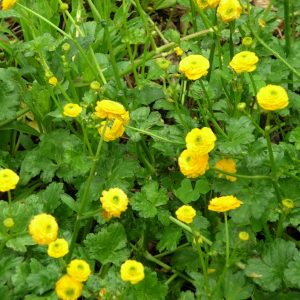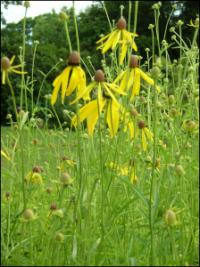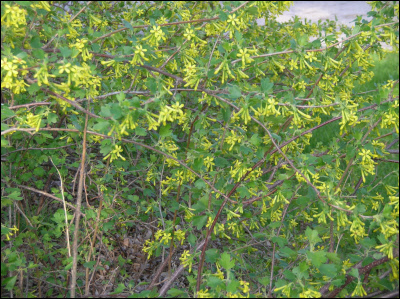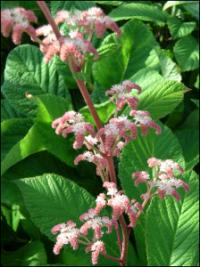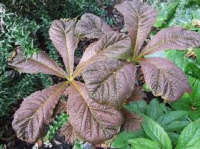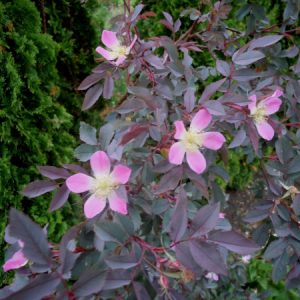Our Plants
Showing 481–488 of 616 results
-
Ranunculus repens var. pleniflorus Creeping buttercup Z 3-9
Small bright yellow nearly ball-shaped flowers May - June
Small bright yellow nearly ball-shaped flowers May – June
LIMITED QUANTITES AVAILABLE, LIMIT OF 1 PER CUSTOMER PLEASE
Size: 8-12" x 10" spreading
Care: Part sun to shade in moist soil
Native: Europe, Siberia, from Newfoundland to VirginiaRanunculus is Latin for little frog, so named by Pliny in Roman times referring to the wet conditions required by some ranunculus. In 1629 John Parkinson, apothecary to James I and royal botanist to Charles I, called this Ranunculus protensis flore multiplici. The root was supposed to break persistent sores by “drawing the venome to the place.” Jefferson planted Creeping buttercup at Monticello in 1782; it may or may not have been this double.
-
Ratibida pinnata Prairie coneflower Z 3-8
Skirt of drooping, sunny, thin petals surround erect brown cone on this fragrant flower, smelling of anise, June-August.
Skirt of drooping, sunny, thin petals surround erect brown cone on this fragrant flower, smelling of anise, June-August.
Size: 4' x 18"
Care: sun to part shade in any soil
Native: Ontario, VT to FL, SD to OK, incl. Wisconsin
Wildlife Value: Butterfly plant. Birds eat seeds.Pinnata means “feathery” in Latin referring to the thin petals of the flower. 1st Americans cured toothaches with the root & made tea from the cone and leaves. Collected by French explorer Michaux on the prairies of Illinois in 1795.
-
Rheum palmatum var. tanguticum Ornamental rhubarb Z 4-8
Gigantic, jagged-edge, bronze-tinted turning green foliage with pink plumes reaching skyward atop tall stalks in early summer.
OUT OF STOCK
Gigantic, jagged-edge, bronze-tinted turning green foliage with pink plumes reaching skyward atop tall stalks in early summer.
Size: 8' x 6'
Care: Sun to part shade, moist well-drained fertile soil, mulch in spring
Native: valleys of Gansu, Qinghai, Shaanxi, Xizang, ChinaRhubarb carried from its native China to central Asia and then to Europe by caravans more than 2000 years ago. Both Dioscorides and Pliny mentioned the plant during the 1st century A.D. In 1300’s Marco Polo explained that merchants of China do not take beasts of burden into the mountains where rhubarb grows because “if eaten by them, has the effect of causing the hoofs of the animal to drop off.” This variety 1st described in 1874
-
Ribes aureum syn. Ribes odoratum Clove currant Z 3-8
yellow flowers smother the shrub
Early to mid-spring yellow flowers smother the shrub, giving off the most sweet, clove-scented fragrance – heavenly.
Size: 6' x 6'
Care: Sun in moist well-drained to well-drained soil. Immune to Walnut toxins.
Native: west-central US
Wildlife Value: attracts hummingbirds and butterflies.Found by Meriwether Lewis in 2 locations -“near the narrows of the Columbia.” April 16, 1806, now Klickitat County, Washington, and on July 29, 1805 in Montana. Many different tribes ate the berries – Blackfoot, Cheyenne, Klamath, Montana, Paiute & Ute. Others, Shoshone and Paiute, used the shrub’s inner bark to heal sores and swellings. English plantsman Wm. Robinson declared that it “deserves to be more commonly grown.” (1933)
**LISTED AS OUT OF STOCK BECAUSE WE DO NOT SHIP THIS ITEM. IT IS AVAILABLE FOR PURCHASE AT OUR RETAIL LOCATION.
-
Rodgersia aesculofolia Finger-leaf rodgersia Z 5-7
Showy, fragrant, pink-tinged, ivory flowers along stems rising up to 2’ over basal foliage. Come for the flowers and stay for the foliage - 12” wide bronze-tinted, crinkled, double-tooth edged, palmate shaped of seven leaflets radiate like spokes of a wheel.
Showy, fragrant, pink-tinged, ivory flowers along stems rising up to 2’ over basal foliage. Come for the flowers and stay for the foliage – 12” wide bronze-tinted, crinkled, double-tooth edged, palmate shaped of seven leaflets radiate like spokes of a wheel.
Size: 3-5’ x3-5’
Care: sun to part shade in moist well-drained to wet soil
Native: northern ChinaFirst collected in Sichuan province, China by Siberian Grigorii Potanin (1835-1920) in 1884. Trudy Imp. S.-Peterburgsk. Bot. Sada vol 13 p. 96 (1893). For his political activity as a Siberian separatist Potanin spent years in Russian prison. An accomplished geographer and naturalist he explored much of Kazakhstan and Mongolia and parts of China. In 1879-1880 he explored northern Mongolia collecting many plants and animal specimens.
-
Rodgersia pinnata Rodger’s flower Z 5-8
July-August pink, sometimes white, panicles top crinkly, lance-shaped, palmate leaves
July-August pink, sometimes white, panicles top crinkly, lance-shaped, palmate leaves
Size: 3' x 30"
Care: shade in moist soil
Native: China
Wildlife Value: deer resistant.
Awards: England’s Royal Horticultural Society Award of Merit & Elisabeth Carey Miller Botanical Garden Great Plant PicksRodgersia named for American Admiral John Rodgers (1812-1882) who led an expedition in the Pacific in 1852 during which the 1st species of this genus was discovered. This species introduced from its native China by Ernest “Chinese” Wilson (1876-1930) by 1910.
-
Rodgersia podophylla Bronze-leaf rodgersia In China: gui deng qing Z 5-8
Blooming, creamy white panicles in summer, atop five leaflets, shield-shaped, jagged incisions at the ends forming a palmate shape.
Blooming, creamy white panicles in summer, atop five leaflets, shield-shaped, jagged incisions at the ends forming a palmate shape.
Size: 3-5’ x 3-4’ and slowly spreading by rhizomes.
Care: part shade in moist to moist well-drained acidic soil
Native: woodland & stream edges in Japan, China & Korea
Awards: Elisabeth Carey Miller Botanic Garden, Great Plant Pick Award.Rodgersia named for American Admiral John Rodgers (1812-1882) who led an expedition in the Pacific in 1852 during which this plant was collected. 1st mentioned in literature 1858. Named by Harvard botanist Asa Gray. Species name from the Greek for foot (podos) and leaf (phyllon).
-
Rosa rubrifolia syn. Rosa glauca Z 3-9
Medium pink single blooms in spring. Purplish foliage bearing red-purple hips in autumn.
OUT OF STOCK – EMAIL FOR AVAILABILITY
Medium pink single blooms in spring. Purplish foliage bearing red-purple hips in autumn.
Size: 7’ x 5’
Care: Full sun to part shade in moist well-drained soil. Disease resistant. Japanese beetles seem not to be interested in this rose.
Native: Central Europe
Awards: Plant Select; Elisabeth Carey Miller Botanical Garden Great Plant Pick & Great Plants for Great Plains; Royal Botanical Society Award of Garden MeritIn garden cultivation since 1830
**LISTED AS OUT OF STOCK BECAUSE WE DO NOT SHIP THIS ITEM. IT IS AVAILABLE FOR PURCHASE AT OUR RETAIL LOCATION.

